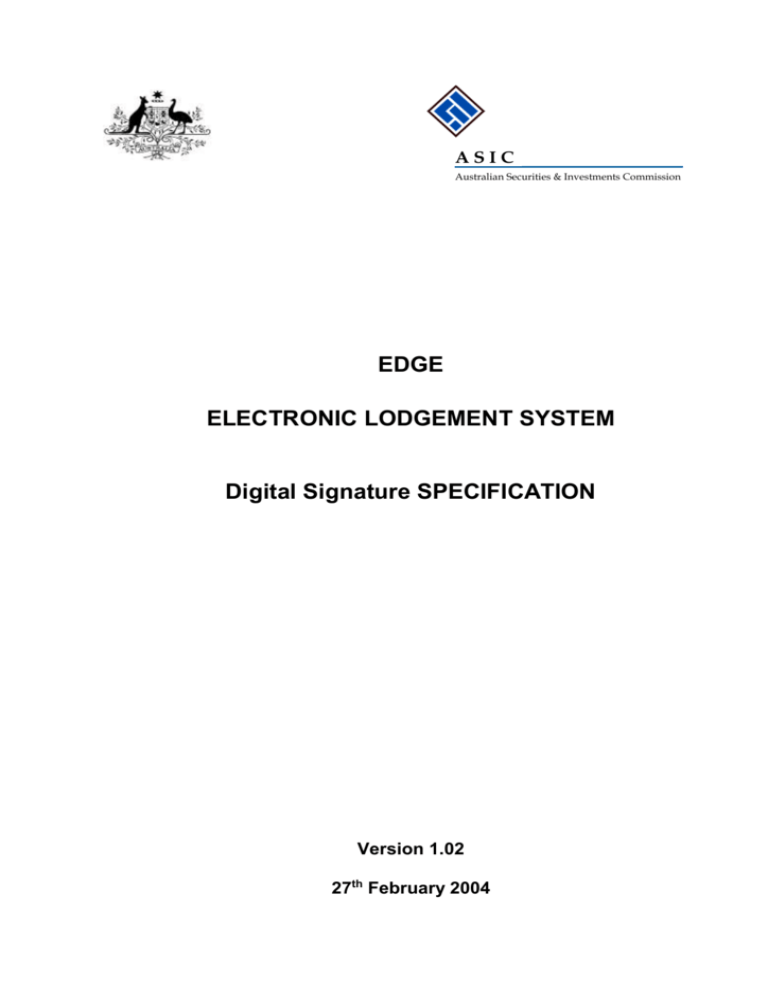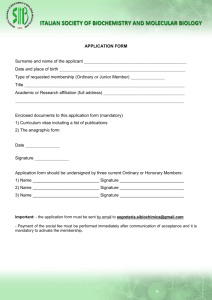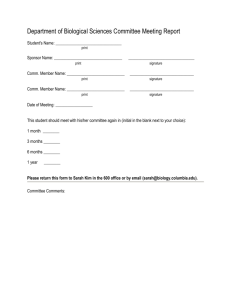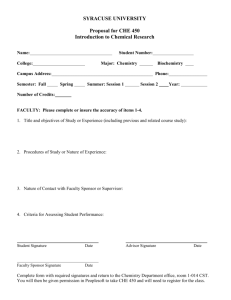
ASIC
Australian Securities & Investments Commission
EDGE
ELECTRONIC LODGEMENT SYSTEM
Digital Signature SPECIFICATION
Version 1.02
27th February 2004
Digital Signature Specification
ASIC
Notice To Readers
This specification is current at the latest date shown in the Amendment History, but it may be
amended at any time without prior notice. Only developers of packages currently registered for
the Electronic Company Registrations component of EDGE lodgement will be notified of
changes.
ASIC is not responsible for the quality or merchantability of software developed on the basis of
this specification, nor is it responsible for any application packages developed by third parties to
prepare and lodge documents onto the EDGE system. ASIC does not support such software in
any form.
Copyright© Australian Securities & Investments Commission 1994-2004 with all rights reserved
This document is the property of ASIC. No part of this document may be copied and used in
other publications unless ASIC authorship is acknowledged
ii
Digital Signature Specification
ASIC
Contents
1. INTRODUCTION .................................................................................................................... 1
1.1. Who should read this document ................................................................................. 1
1.2. The purpose of this document .................................................................................... 1
1.3. Other relevant documentation .................................................................................... 1
1.4. Where to get help ....................................................................................................... 1
2.
BUSINESS RATIONALE FOR USE............................................................................... 2
2.1. Why are digital signatures being used ........................................................................ 2
Document signature ..................................................................................................... 2
Transmission signature ................................................................................................ 2
2.2. When are digital signatures to be used ....................................................................... 2
2.3. Signing documents ..................................................................................................... 2
2.4. Signing transmissions ................................................................................................. 3
2.5. Certification Authorities ............................................................................................. 3
2.6. Authorising certificates .............................................................................................. 3
2.7. Security of private keys .............................................................................................. 4
2.8. Other security services for the Internet ....................................................................... 4
2.9.Gatekeeper specifications ................................................................................................ 4
3.
TECHNICAL SPECIFICATION .................................................................................... 6
3.1. Base-64 encoding ....................................................................................................... 6
3.2. Encoding a certificate ................................................................................................. 6
3.3. Encoding a signature .................................................................................................. 6
3.4. Signing a document .................................................................................................... 6
3.5. Signing a transmission................................................................................................ 7
3.6. Self Authorised Transmissions ................................................................................... 8
RA53s .......................................................................................................................... 8
Future Use .................................................................................................................... 8
3.7. Useful libraries ........................................................................................................... 8
OpenSSL (formerly SSLeay) ....................................................................................... 8
3.8. Test keys for software developers .................................................................................. 9
3.9. Implications for X.25 users ............................................................................................ 9
3.10 Format of Distinguished Names .................................................................................... 9
3.10.1 Overview........................................................................................................... 9
3.10.2 Rules ................................................................................................................. 9
3.10.3 RFC1779 Keyword/Attribute table ................................................................. 10
3.10.4 Examples ........................................................................................................ 10
3.11 Error Codes for ECR Validation Signature Errors ...................................................... 10
4.
Recognition for EDGE lodgement .................................................................................. 13
4.1. Certification authorities ................................................................................................ 13
4.2. Key storage media ........................................................................................................ 13
Appendix A - Amendment History ........................................................................................... 14
Version 00.10 ............................................................................................................. 14
Version 00.90 ............................................................................................................. 14
Version 00.95 ............................................................................................................. 14
iii
Digital Signature Specification
ASIC
Version 01.00 ............................................................................................................. 14
Version 01.01 ............................................................................................................. 14
Version 01.02 ............................................................................................................. 14
iv
Digital Signature Specification
ASIC
1. INTRODUCTION
1.1. Who should read this document
This document is written for persons developing software which creates electronic
documents intended for transmission to ASIC's EDGE system.
This document covers the requirements for digital signature of documents and
transmissions.
This document may be of interest to persons investigating problems with such
software, persons using such software and persons developing other Corporations
Law related software.
1.2. The purpose of this document
This document describes the use of digital signatures with ASIC's EDGE electronic
lodgement system.. It must be read in conjunction with the other EDGE
documentation listed in 1.3 below, in particular the EDGE messages specification.
It describes the requirements for:
the business rationale
the technical specifications
1.3. Other relevant documentation
EDGE specifications are available for download from
"http://www.search.asic.gov.au/~edge/".
Publicly available documentation of ASIC's EDGE electronic lodgement system is
listed in the Document Summary document in these specifications.
ASIC may prepare other specifications and directions from time to time. They will
be distributed to registered software developers.
1.4. Where to get help
Refer to the Documentation Summary specification
Page 1
Digital Signature Specification
ASIC
2. BUSINESS RATIONALE FOR USE
2.1. Why are digital signatures being used
Document signature
To provide an appropriate level of authentication for electronically lodged
documents, ASIC will utilise digital signatures generated using the private key
associated with an X.509 certificate issued by an approved certification authority.
Digital signatures will be mandated for certain company registration messages.
Digital signatures may optionally be used on other documents, provided that the
signatory possesses a suitable X.509 certificate and the agents trading agreement
authorises its use.
Transmission signature
Company registration documents are high value documents whose lodgement incurs
a debt from the lodging party to ASIC. To provide a level of authentication and
security commensurate with the transaction values that may be involved, such
transmissions must be digitally signed.
Additionally, the use of the Internet requires additional measures to ensure message
integrity. All transmissions using the Internet which contain documents requiring
digital signature as described above, must also be digitally signed. Transmissions
that do not contain such documents do not require a digital signature. Where the
transmission does not contain digital signature, the SSL session encapsulation of
authentication and transmission is taken to provide sufficient message integrity.
2.2. When are digital signatures to be used
The EDGE Electronic Lodgement Protocol, available from ASIC's home page at
http://www.asic.gov.au, determines the conditions of use of digital signatures.
In summary, at time of writing
Documents must be digitally signed when the relevant message
specification indicates that the digital signature segments (ZXI/ZXS) are
mandatory. Mandatory digital signatures apply to company registration
documents.
Other documents may be digitally signed.
Transmissions must be signed if they contain company registration
messages.
2.3. Signing documents
Company registration documents must be digitally signed by the applicant.
Page 2
Digital Signature Specification
ASIC
Where a company officer is required to sign register documents, and the officer has
obtained an approved X.509 certificate, then the register document may be digitally
signed.
2.4. Signing transmissions
Transmissions must be digitally signed if they contain documents which themselves
require digital signatures, to
provide message integrity for messages transmitted over the internet
for company registration messages, to acknowledge agent responsibility for
payment of statutory charges for company registration messages included in the
transmission
2.5. Certification Authorities
ASIC will recognise certificates issued by one or more third party commercial
certification authorities. ASIC intends to recognise certification authorities that
meet the whole of government requirements defined by the GateKeeper project.
The EDGE Electronic Lodgement Protocol, available from ASIC's home page at
http://www.asic.gov.au, provides details of Certification Authorities whose
certificates may be used with the EDGE system.
Chapter 4 provides further details.
2.6. Authorising certificates
This section does not apply to agents who have do not intend to lodge company
registration documents". These non-ECR agents may use the EIS service without
client certificates.
In the current implementation of digital signatures, ASIC will operate a closed
system with its registered agents. A trading agreement will be entered into before
lodgment is permitted.
Within this closed environment, agents will need to set authorities attached to
certificates directly with ASIC using EDGE messages, in addition to any revocation
which the agent may perform to their certification authority. Changes to certificate
authorities, and notification of new certificates, are made using an RA53 message,
signed by an already authorised certificate
Page 3
Digital Signature Specification
ASIC
On first entering a trading agreement with ASIC to lodge company registration
transmissions, an agent will be provided with a single use PIN number to authorise
the first certificate. This PIN must be sent to ASIC in a transmission signed using
certificate to be initially authorised. This is called a "self authorised" message. This
method will also be used if a new initial certificate needs to be authorised. This
might occur if, for example, the only authorised certificate is lost.
Certificates may be authorised at two levels
transmission signature, which includes authorising the creation of a debt by the
agent to ASIC for statutory fees payable on company registration messages
included in a transmission
document signature, as an applicant or a company officer
A certificate may be authorised at both levels.
2.7. Security of private keys
The terms and conditions for issue of X.509 certificates generally place certain
responsibilities on the user of the certificate to secure the private key.
The technology used to store the private key has a major impact on the level of
security provided. In particular, storage of private keys on computer hard disks is
considered to provide only a very low level of security and does not meet the
GateKeeper requirements.
Software developers are referred to various Internet information sources for details
on the ease with which keys stored on hard disk can be uploaded and mis-used.
GateKeeper recognises storage on floppy diskette, PCMCIA cards, removable disks
and smart cards.
2.8. Other security services for the Internet
Digital signature of transmissions will provide a high level of message integrity and
user authentication for EDGE lodgements both over the Austpac X.25 service and
over the Internet.
For Internet traffic, ASIC will also run encrypted traffic to provide confidentiality of
traffic content. This will be achieved by using SSL-3 encryption between server and
client using 128bit encryption keys. The SSL-3 sessions will not utilise client
authentication using client X.509 certificates. This will be provided by the
encrypted user id/password pair, plus the digital signature of transmissions, for
transmissions containing registration documents.
2.9.Gatekeeper specifications
At time of writing, the GateKeeper report is available from the National Office of
the Information Economy at
Page 4
Digital Signature Specification
ASIC
http://www.noie.gov.au
Page 5
Digital Signature Specification
ASIC
3. TECHNICAL SPECIFICATION
3.1. Base-64 encoding
The EDGE message definition language supports a base64 encode element. This
must be encoded according to RFC1421. In creating EDGE segments, the newline
character defined to delimit base64 also serves as the EDGE segment delimiter.
3.2. Encoding a certificate
Before being used to sign ASIC messages, certificates must be authorised to ASIC
using an RA53 message. The certificate must be base64 encoded, then assembled
into a set of ZXC segments as defined in this message.
3.3. Encoding a signature
Digital signatures are appended to EDGE messages as a ZXI segment to identify the
certificate containing the public key, and a set of ZXS segments containing the
base64 encoded signature.
3.4. Signing a document
The message digest on an EDGE document must be hashed over the complete data
component of the message, commencing with the ZHD header segment, and ending
with the new-line which delimits the ZTR trailer segment.
If the document is signed using a certificate which has not been pre-authorised to
ASIC using an RA53 (in this specification, referred to as self authorising), the
base64 encoded certificate is assembled as ZXC segments and appended to
message.
Attention: In the current implementation of EDGE, the only messages which may be self
authorised are RA53 messages which contain an ASIC issued single use PIN to
allocate authorities to the certificate.
A ZXI segment is then appended to the message to identify the X.509 certificate
associated with the private key being used to sign the document and to advise
algoriths used.
The digital signature is then calculated, encoded to base64 according to RFC1421,
converted to a set of ZXS segments according to EDGE requirements and appended
to the message.
Page 6
Digital Signature Specification
ASIC
3.5. Signing a transmission
Form 201
applicant digital signature
Form 201
applicant digital signature
TXID transmission control
agent digital signature
All documents (including digital signature segments if appropriate) to be
transmitted are assembled into a single message and the TXID file is appended.
The message digest must be hashed over the assembled message, starting at the start
of the first ZHD segment, and ending with the newline of the ZTR segment of the
TXID.
If the transmission is signed using a certificate which has not been pre-authorised to
ASIC using an RA53 (in this specification, referred to as self authorising), the
base64 encoded certificate is assembled as ZXC segments and appended to
message.
Attention: In the current implementation of EDGE, the only transmissions which may be self
authorised are those containing a single RA53 message which contains an ASIC
issued single use PIN to allocate authorities to the certificate.
A ZXI segment is then appended to the message to identify the X.509 certificate
associated with the private key being used to sign the transmission.
The digital signature is then calculated, encoded to base64 according to RFC1421,
converted to a set of ZXS egments according to EDGE requirements and appended
to the message.
Page 7
Digital Signature Specification
ASIC
3.6. Self Authorised Transmissions
RA53s
Because certificates are normally pre-authorised to ASIC using a signed RA53
message, it is not normally necessary to transmit the X.509 certificate as part of the
digital signature group.
However, this is not the case when an agent first joins the EDGE Company
Registrations system, or in re-establishing authorities if the only authorised
certificate is lost. In these cases, it is necessary to use a self authorised transmission
of an RA53 message which in turn contains a single use ASIC issued PIN.
A self authorised transmission must contain one and only one RA53 message,
which in turn must contain the ASIC issued PIN. The ZXC segments within the
digital signature group of the RA53 must contain the certificate used to sign the
document. This certificate must match the certificate whose authorities are being set
by the RA53. Similarly, the transmission must be signed by this certificate and the
signature group of the TXID must contain this certificate.
Future Use
As the use of digital signatures developes and the structures which support levels of
trust in these signatures matures, ASIC may accept messages signed using
certificates which have not been pre-authorised using an RA53 message.
The structure of the digital signature group will allow certificates to be transported
as part of these messages
3.7. Useful libraries
OpenSSL (formerly SSLeay)
OpenSSL is a widely used software package which provides comprehensive SSL
and X.509 cryptographic services. The package is extremely popular with
developers and is incorporated in many commercial packages. Its popularity stems
from:
it is comprehensive and of high quality.
it was developed outside the US, in Australia, and so is not subject to the US
laws prohibiting export of strong cryptographic software which affect much of
the world’s commercial cryptographic libraries.
the package is available in source form, so patches can be quickly applied.
it is free. This helps to guarantee availability and ensures good Internet-based
support.
The package is available via the Internet from:
Page 8
Digital Signature Specification
ASIC
ftp://ftp.psy.uq.oz.au/pub/Crypto/SSL
A search in any of the major Internet search engines on the keyword “ssleay” will
quickly reveal many mirror sites and related resources.
3.8. Test keys for software developers
ASIC can provide test certificates and private keys for developers of EDGE
software.
Software developers who intend to provide digital signature capability should
contact the EDGE systems team.
3.9. Implications for X.25 users
EDGE messages are defined to use a restricted character set. However, use of
certain characters such as the carriage return has historically been tolerated to retain
DOS compatability.
Such characters may be removed by transmission protocols such as Zmodem in
ASCII mode. As the digital signature digest would have been calculated to include
those characters, the signature check would fail and EDGE would reject the
document.
Developers should restrict their messages to the defined character set.
As a fall back, it is possible to force Zmodem binary transfer, although ASIC does
not recommend this approach and does not guarantee future compatability.
3.10 Format of Distinguished Names
3.10.1 Overview
Distinguished names in X.509 certificates are represented internally using ASN1
Abstract Syntax Notation One), but there is no definitive format for external string
representations. ECR follows the SSLeay (now OpenSSL) usage, which follows
Internet RFC1779.
3.10.2 Rules
Rules are as follows:
distinguished names (DN's) must be shown as a set of key/attribute pairs
separated by "/" characters.
attribute values must be extracted from the cerificate, in the same order as they
appear in the certificate.
The DN must include all attributes contained in the certificate for the DN.
Page 9
Digital Signature Specification
ASIC
Each key/attribute pair must be of the form: key=attribute where "key" can be
one of the names shown on the LEFT side of the RFC1779 Keyword/Attribute
table below. These keywords must be in UPPER CASE.
if certificates issued by suppliers accepted by ASIC for ECR contain elements
prefixed by keywords other that those in the table, then those keywords must be
rendered as they appear in the certificate, but in UPPER CASE
Key/attribute pairs must be separated by "/" characters. This follows the
SLeay/OpenSSL usage when displaying subject names, and follows the OSF
Syntax, as referred to by this phrase in RFC 1779 :
"The OSF Syntax may be more appropriate for some system oriented uses.
(The OSF Syntax uses "/" as a separator, and forms names in a manner
intended to resemble UNIX filenames)."
Attribute values extracted from certificates must be shown EXACTLY as they
occur in the certificate, hence they are case sensitive.
3.10.3 RFC1779 Keyword/Attribute table
Key
CN
L
ST
O
OU
C
STREET
Attribute (X.520 keys)
CommonName
LocalityName
StateOrProvinceName
OrganizationName
OrganizationalUnitName
OrganizationalUnitName
OrganizationalUnitName
3.10.4 Examples
These are valid for ECR:
/C=au/O=KeyPOST Test CA
/C=AU/O=ECR Test CA
These are NOT valid for ECR:
/c=au/O=KeyPOST Test CA
(key "c" is in lower case, must be upper)
/C=AU/O=KeyPOST Test CA
(in the circumstance where the actual
certificate shows lower case "au" as the country, so it must appear here in
lower case.)
3.11 Error Codes for ECR Validation Signature Errors
Where digital signatures fail verification, a message similar to these two messages
will appear in the validation report:
Page 10
Digital Signature Specification
ASIC
X027 Digital signature verify failed, X509 verify retcode=37
X028 BCHN signature verify failed, X509 verify retcode=37
The item of interest in these messages is the retcode. Most return codes indicate
internal errors and are not visible to clients, i.e. they do not appear in validation
reports. The values and meanings of those codes likely to appear in validation
reports are:
Retcode value
25
Meaning
No signature found
26
27
Invalid ZXI
Invalid ZXI issuer
28
Invalid ZXI hashcode
29
Invalid ZXI crypt
35
X509 read error
37
Signature verify failed
Explanation and Solutions
Decode software could not find a signature check that a signature was appended and it was
in the correct place.
The ZXI segment was not correctly formed.
The issuer DN found in a ZXI segment did not
match any of the DNs of issuers accepted by
ASIC for ECR.
The code indicating the hashcode used in
producing the message digest is not one
supported by ECR. MD5, SHA1 and SHA-1 are
supported.
The code indicating the encryption algorithm
used for the signature is not one supported by
ECR. RSA is supported.
The decode software could not read the X509
certificate, probably indicating the certificate is
corrupt, not a certificate, or incorrectly
represented in the message. Review method used
to encode the certificate.
The decode software signature verification
processing indicated that the signature was not
correct. This can be because the signature was
not that of the data sent e.g. the wrong data
buffer was signed, or it can be because the
signature data structure is not a valid digital
signature. This usually indicates signature
software failure.
The most common causes of signature errors are:
operator does not insert smartcard in reader, but software does not detect error.
This often results in signatures with no data in the ZXI segments.
client software does not sign the exact data required to be signed. Document
signatures must sign the data from the start of the ZHD header segment up to and
including the linefeed character at the end of the ZTR trailer segment. BCHN
(i.e. message) signatures must sign all data from the start of the message to the
linefeed character at the end of the TXID ZTR trailer segment in the TXID
appended to the BCHN.
Page 11
Digital Signature Specification
ASIC
client software appends carriage returns or other data after signature. ECR must
receive exactly the bit-string signed, no more, no less, or the signature
verification will fail.
client software generating the signature fails, due to incorrect version, incorrect
configuration, or bugs. If this software is third-party, which most are, then
consult your vendor software support.
Note that signature verification errors should never occur if the client software
correctly performs a signature verification prior to sending the message to ECR. In
practice this can be difficult to achieve, because often if errors occur the verification
processing repeats the error in the original signature processing. Nevertheless
software developers are encouraged to build in independent signature verification
where this is possible, so that invalid signatures do not leave the client machine.
Page 12
Digital Signature Specification
ASIC
4. Recognition for EDGE lodgement
4.1. Certification authorities
EDGE will recognise private/public key pairs and X.509 certificates issued by
the certification authorities specified in the EDGE Electronic Lodgement
Protocol, available from the ASIC Home Page at http://www.asic.gov.au
4.2. Key storage media
EDGE will recognise the following key storage media
crypto smart card (strongly recommended)
memory smart card
floppy diskette
PCMCIA card
removable hard disk
Page 13
Digital Signature Specification
ASIC
Appendix A - Amendment History
Version 00.10
Released to software suppliers as a draft for information on 31/03/98.
Version 00.90
Released to software suppliers as a draft on 30/06/98.
Version 00.95
Released to software suppliers as a draft on 04/09/98.
Change 2.1, 2.3, 2.6, 3.4, 3.5
Add 3.6
Version 01.00
Released to software suppliers on 09/10/98.
Initial production release with no changes from the version 0.95 draft.
Version 01.01
Released to software suppliers on 12th November 2001
4.1 – refer to the EDGE protocol for supported certification authorities.
Added 3.10 Format of Distinguished Names. This section provides detailed rules
and examples for construction of Distinguished Names in ECR messages.
Added 3.11 Error Codes for ECR Validation Signature Errors. This section provides
error codes, causes and explanations for all errors that clients and software
developers are likely to see. A guide to common signature errors is also included.
Version 01.02
Released to software suppliers on 27th February 2004
Changes to allow lodgement of documents other than Electronic Company
Registration documents via the Edge Internet Interface without the need for
digital signatures:
Section 2.1, para headed "Transmission signature", change the last sentence to read:
Page 14
Digital Signature Specification
ASIC
"All transmissions using the Internet which contain documents requiring digital
signature as described above, must also be digitally signed. Transmissions
which do not contain such documents do not require a digital signature.
Where the transmission does not contain digital signature, the SSL session
encapsulation of authentication and transmission is taken to provide sufficient
message integrity."
Section 2.2, first para, third dot point, remove:
", or if they are transmitted over the Internet".
Section 2.4, first line, insert between "signed" and "to":
"if they contain documents which themselves require digital signatures".
Section 2.6, insert before the first para:
"This section does not apply to agents who have do not intend to lodge company
registration documents". These non-ECR agents may use the EIS service
without client certificates."
Section 2.8 at the end where it says "plus the digital signature of transmissions",
add:
", for transmissions containing registration documents".
Reelased to software developers on 26 February 2014
Section 3.11 – Retcode 28, add reference to SHA1
Page 15








